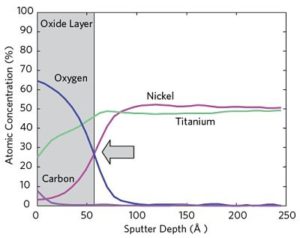Biomedical Surface Analysis
Home » Biomedical Surface Analysis
Biomedical surface properties are critical to medical and pharmaceutical products, and surface chemistry investigations offer answers to difficult problems. For example, surface properties are key to the biocompatibility of a material or device. An improperly treated surface may be harmful to the patient, and depending on these characteristics could trigger an allergic response, bacterial infection, or even a blot clot.
Surface contaminants not only reduce biocompatibility but can also alter the surface properties critical to the function of the biomaterial. Contaminants may originate from chemicals, solvents, or tools used in the manufacturing, processing, and cleaning of a medical device and biomaterials. Corrosion, oxidation, or coatings degradation may also contaminant a biomedical surface.

The chemistry of the upper monolayer of a surface can have a dramatic effect on surface wetting, biocompatibility, reactivity, and adhesion. For example, plasma processing and other gas-phase treatments are routinely used to alter the near-surface chemistry of polymer films prior to printing or adhesion steps. Similarly, organic silanes and thiol-terminated self-assembled monolayers can be applied from solution to modify the surface chemistry of glasses and metals.
EAG Laboratories is well versed in the various factors that can affect biomedical surface chemistry, and thus is able to help determine the most relevant analytical approach, to obtain the best results. Many different analytical techniques are available for understanding the issues associated with:
- Surface coverage
- Molecular orientation
- Functionalization
- Contamination
- Surface segregation
Depth profiles are plots that show concentration (y-axis) with respect to depth (x-axis). They can be obtained by continuously monitoring specific species of interest with respect to depth (e.g. SIMS), or in a stepwise manner by removing material, measuring, and then repeating the process (e.g. XPS or Auger). The thickness of the layers of interest and the detection limits required are important factors in choosing the best technique for a given sample.
If not done properly, artifacts and errors can be introduced into depth profiles due to the complexity of the measurement. EAG has a thorough understanding of how to acquire depth profiles under optimized conditions without introducing needless artifacts, based on many years of prior experience across many sample types.
Would you like to learn more about Biomedical Surface Analysis?
Contact us today for your biomedical surface analysis needs. Please complete the form below to have an EAG expert contact you.